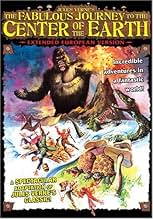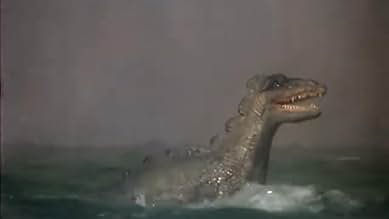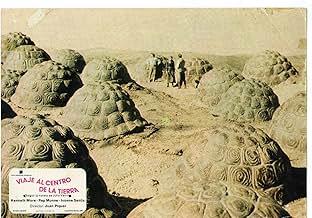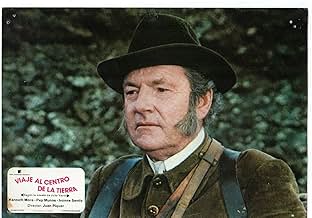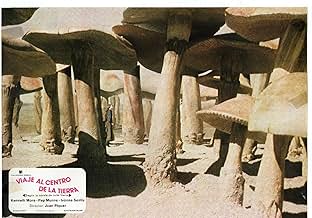IMDb RATING
4.8/10
881
YOUR RATING
Also known as "The Fabulous Journey to the Centre of the Earth" in the UK. The film is partially dubbed in English, but it has good cinematography.Also known as "The Fabulous Journey to the Centre of the Earth" in the UK. The film is partially dubbed in English, but it has good cinematography.Also known as "The Fabulous Journey to the Centre of the Earth" in the UK. The film is partially dubbed in English, but it has good cinematography.
José María Caffarel
- Professor Fridleson
- (as Jose Mª Caffarel)
Fabián Conde
- Professor
- (as Fabian Conde)
Ángel Álvarez
- Professor
- (as Angel Alvarez)
Ángel Menéndez
- Professor
- (as Angel Menendez)
Featured reviews
Very nearly qualifying for 'so bad, it's good' status, Spanish director Juan Piquer Simon's take on Jules Verne's classic tale is poorly acted, has some truly awful effects, and features the most inept bunch of explorers ever to be committed to celluloid. With a touch more manky monster action, and its tongue a bit further in cheek, this one could have rivalled 70s favourite At the Earth's Core for schlock value; as it stands, it is a fairly entertaining low budget adventure flick that is just about enough fun for it to warrant a viewing.
Kenneth More plays Prof. Otto Lindenbrock, a geologist who sets out on an expedition after discovering a secret route to the centre of the Earth. Together with his niece Glauben (Ivonne Sentis), a Prussian soldier, Axel (Pep Munné), and a shepherd named Hans (Frank Braña), Otto braves dangerous cave-ins, poisonous mushrooms, a perilous sea journey and prehistoric creatures.
Unlike James Mason's more than capable Oliver Lindenbrook (in the far superior 1959 movie Journey to the Center of the Earth), More's character is something of a bumbling fool. He is totally unprepared for the trip he undertakes and doesn't seem at all fazed by any setbacks (he loses his guidebook and water supply along the way, but continues regardless). His companions, who all seem quite happy to tag along, are equally irresponsible; they frequently wander off on their own with absolutely no regard for their own safety.
On discovering a huge underground ocean, the travellers build a raft, bump into some sea monsters (rubber glove puppets filmed in a bath), visit an island full of man-eating tortoises (the world's slowest predators) and get attacked by a giant ape (played by a man in a fancy-dress monkey suit). They eventually emerge from an erupting Stromboli, none the worse for wear.
All of this, believe it or not, is fairly faithful to Verne's novel, but Juan Piquer Simon, apparently not content with its level of silliness, ramps up the ridiculousness even further. Halfway through their journey, our intrepid gang meet a mysterious stranger called Olsen, who eventually turns out to be a time-travelling scientist! Fans of bad monster movies and silly 70s sci-fi cinema will probably want to check this film out; everyone else would be better off giving it a miss.
Kenneth More plays Prof. Otto Lindenbrock, a geologist who sets out on an expedition after discovering a secret route to the centre of the Earth. Together with his niece Glauben (Ivonne Sentis), a Prussian soldier, Axel (Pep Munné), and a shepherd named Hans (Frank Braña), Otto braves dangerous cave-ins, poisonous mushrooms, a perilous sea journey and prehistoric creatures.
Unlike James Mason's more than capable Oliver Lindenbrook (in the far superior 1959 movie Journey to the Center of the Earth), More's character is something of a bumbling fool. He is totally unprepared for the trip he undertakes and doesn't seem at all fazed by any setbacks (he loses his guidebook and water supply along the way, but continues regardless). His companions, who all seem quite happy to tag along, are equally irresponsible; they frequently wander off on their own with absolutely no regard for their own safety.
On discovering a huge underground ocean, the travellers build a raft, bump into some sea monsters (rubber glove puppets filmed in a bath), visit an island full of man-eating tortoises (the world's slowest predators) and get attacked by a giant ape (played by a man in a fancy-dress monkey suit). They eventually emerge from an erupting Stromboli, none the worse for wear.
All of this, believe it or not, is fairly faithful to Verne's novel, but Juan Piquer Simon, apparently not content with its level of silliness, ramps up the ridiculousness even further. Halfway through their journey, our intrepid gang meet a mysterious stranger called Olsen, who eventually turns out to be a time-travelling scientist! Fans of bad monster movies and silly 70s sci-fi cinema will probably want to check this film out; everyone else would be better off giving it a miss.
Based on the popular novel by Jules Verne originally called "Journey To The Center Of The Earth", and filmed previously under that title by 20th Century Fox in 1959, this version stars Kenneth More as a scientist who has discovered a way to enter the center of the Earth through Iceland. He takes with him his niece and her fiancée, along with a helper called Hans. Once there, they encounter the usual menaces one can expect, like dinosaurs on the land and sea, as well as a mysterious human named Olsen who will play an important part later... Mediocre film isn't bad but is pretty forgettable; saw this on DVD as a double feature paired with the superior "Encounter With The Unknown".
Back in the mid 70's there was a bit of a cycle of fantasy adventure b-movies. Quite a few of them were British and seemed to always star Doug McClure. One typical example being At the Earth's Core (1976) which was an adaption of sorts of the Jules Verne novel 'Journey to the Center Of the Earth'. Well, it can be of no real surprise that there were also some continental offerings in this sub-genre, and so from Spain we have The Fabulous Journey to the Centre of the Earth. While the British films were made on a fairly low budget, this Iberian equivalent is decidedly cheaper still. It was directed by Juan Piquer Simón who is probably best known for directing a couple of psychotronic 80's horror movies, namely the demented slasher Pieces (1982) and the crazy creature-feature Slugs (1988). I definitely wouldn't say that this film is up to the deliriously entertaining standards of those two but it is still a half-way decent effort.
Set in Victorian times, the story has a scientist discovering a secret entrance to the centre of the earth. He assembles a small party and they navigate down into the abyss where they encounter a mysterious stranger called Olsen (played by Jack Taylor who was the go-to American actor for a plethora of cheap Spanish productions at the time). A little later they encounter prehistoric monsters, giant turtles, a giant ape and...big mushrooms! The low budget hampers things a bit and it isn't directed with much impetus but essentially, any movie which throws in dinosaurs and various other creatures can't be all bad. And this one isn't. Its probably one on the lower side of the prehistoric fantasy sub-genre scale but it still essentially offers the goods, so fair enough.
Set in Victorian times, the story has a scientist discovering a secret entrance to the centre of the earth. He assembles a small party and they navigate down into the abyss where they encounter a mysterious stranger called Olsen (played by Jack Taylor who was the go-to American actor for a plethora of cheap Spanish productions at the time). A little later they encounter prehistoric monsters, giant turtles, a giant ape and...big mushrooms! The low budget hampers things a bit and it isn't directed with much impetus but essentially, any movie which throws in dinosaurs and various other creatures can't be all bad. And this one isn't. Its probably one on the lower side of the prehistoric fantasy sub-genre scale but it still essentially offers the goods, so fair enough.
.Adventure tale full of colorful scenarios and pretty fierce monsters . Amusing and lighthearted romp for kids and teenagers based upon the Jules Verne novel . A scientist (Kenneth Moore), his niece (Ivonne Sentis) and boyfriend (Pep Munne) undergo a hazardous voyage to the center of earth , along the way they face numerous dangers and risks. During the trip , the scientific and his niece hire a wealthy scout (Frank Braña) for an expedition to the centre of the world . As four persons attempt to get to center of the earth by entering into an environment of caves by a volcano located in Iceland. The trio descend into deep caverns and discover a tunnel system leading to the planet's center. On their way they find among other things also prehistoric animals like some dinosaurs. They have to deal with lightning storms, endure torrential floods, volcanic eruptions, turtles, a big gorilla, and discover a forest of giant mushrooms, but not the lost city of Atlantis as happens in the classic novel.
This average adaptation is a special version of the Jules Verne adventure yarn . There're rip-roaring action, spirit of adventure, derring-do, thrills and results to be pretty entertaining . It's a brief fun with average special effects by Emilio Ruiz Del Rio and Francisco Prosper, passable set decoration , functional art direction and none use of computer generator. Fantastic adventures full of monsters in a lost continent on the center of earth . The rubber monsters are the real stars of this production , however being middling made . The fable is silly and laughable , and the effects and action are regularly made . Among the most spectacular of its visuals there are some deeply shrouded caverns , several monsters roaring menacingly towards the camera , a little tableau comprising attack and fighting two giant monsters and the colorful backgrounds of the lost land . Some monsters are clumsily but the movie has some good moments here and there . Some illogical parts in the argument are more than compensated for the excitement provided by the monsters, though sometimes are a little bit cheesy. It's a great fun with naive special effects , passable set decoration and functional art direction without use of computer generator. Highlights of the voyage includes a roller-coaster trip, strong storms, magnetic rocks, a terrifying odyssey in sailing, prehistoric reptile, a Tiranosaurius Rex, and many others. The motion picture is professionally realized by Juan Piquer Simon. Piquer who recently passed away was a craftsman expert on all kind of genres as Terror ( Slugs,Piezes, Cthulhu) and Sci-fi (The rift , The new Extraterrestres, Supersonic man) .Other renditions about this know story are the following : Classic version (1959) by Henry Levin with James Mason as Lindenbrook, Pat Boone,Diane Baker and Arlene Dahl; and TV adaptation by George Miller with Treat Williams, Jeremy London and Bryan Brown.
This average adaptation is a special version of the Jules Verne adventure yarn . There're rip-roaring action, spirit of adventure, derring-do, thrills and results to be pretty entertaining . It's a brief fun with average special effects by Emilio Ruiz Del Rio and Francisco Prosper, passable set decoration , functional art direction and none use of computer generator. Fantastic adventures full of monsters in a lost continent on the center of earth . The rubber monsters are the real stars of this production , however being middling made . The fable is silly and laughable , and the effects and action are regularly made . Among the most spectacular of its visuals there are some deeply shrouded caverns , several monsters roaring menacingly towards the camera , a little tableau comprising attack and fighting two giant monsters and the colorful backgrounds of the lost land . Some monsters are clumsily but the movie has some good moments here and there . Some illogical parts in the argument are more than compensated for the excitement provided by the monsters, though sometimes are a little bit cheesy. It's a great fun with naive special effects , passable set decoration and functional art direction without use of computer generator. Highlights of the voyage includes a roller-coaster trip, strong storms, magnetic rocks, a terrifying odyssey in sailing, prehistoric reptile, a Tiranosaurius Rex, and many others. The motion picture is professionally realized by Juan Piquer Simon. Piquer who recently passed away was a craftsman expert on all kind of genres as Terror ( Slugs,Piezes, Cthulhu) and Sci-fi (The rift , The new Extraterrestres, Supersonic man) .Other renditions about this know story are the following : Classic version (1959) by Henry Levin with James Mason as Lindenbrook, Pat Boone,Diane Baker and Arlene Dahl; and TV adaptation by George Miller with Treat Williams, Jeremy London and Bryan Brown.
"Where Time Began" is an adaptation of Jules Verne's "Journey to the Center of the Earth", with some variations to make it more salable (such as a love interest). It seems to have been aimed at a juvenile audience and is in the same vein as the Kevin Connors/Amicus Studios adaptations of Edgar Rice Burroughs. Like many genre films, "Where Time Began" has very hokey characters and dialogue. The ineptitude with which the journey to the center of the earth is conducted is quite startling, in fact. The stupidity of their dialogue (especially the exchanges between Glauben and her idiotic fiancee Axel) gives the film a strong tone of campiness and unintentional humor. When Olsen shows up to rescue them midway through and complains that he's had to listen to their stupid chatter for the past ten miles, the viewer can commiserate. However, given the fact that it is a low budget film, the sets, photography and giant creature special effects are actually pretty good, and they manage to maintain some atmosphere throughout the production. Once the characters arrive in the pseudo-prehistoric world at the center of the earth, the film especially picks up, and the revelation of the origin of Olsen provides an interesting twist. For this reason, "Where Time Began" is a reasonable entry in the journey-to-a-lost-world genre.
Did you know
- TriviaNever released in British theaters, this film was first released in the UK on ITV during Christmas Day of 1978.
- Goofs(at about four minutes and 56 seconds into the film) In the film's English dubbed version, Professor Kristoff uses different measurement units in three consecutive sentences: "Because the distance between the Earth's crust and its core is over 6,500 KILOMETERS. And no man has ever descended to a depth of more than THREE MILES. So it's obvious we'll never have a glimmer of true knowledge until we are able to reach a depth of at least a HUNDRED LEAGUES."
- ConnectionsFeatures Le Voyage dans la Lune (1902)
- How long is Where Time Began?Powered by Alexa
Details
- Release date
- Country of origin
- Languages
- Also known as
- Journey to the Center of the Earth
- Filming locations
- Production company
- See more company credits at IMDbPro
- Runtime
- 1h 30m(90 min)
- Sound mix
- Aspect ratio
- 1.66 : 1
Contribute to this page
Suggest an edit or add missing content


